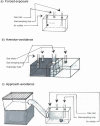Evidence for consistent individual differences in rat sensitivity to carbon dioxide
- PMID: 31017958
- PMCID: PMC6481838
- DOI: 10.1371/journal.pone.0215808
Evidence for consistent individual differences in rat sensitivity to carbon dioxide
Abstract
Carbon dioxide (CO2) gradual-fill is commonly used to kill laboratory rats, but this use remains controversial due to a lack of agreement between studies. Inconsistencies may arise from differences in behaviors measured (e.g. active versus passive behaviors), in how rats cope with threats, or in rat sensitivity to CO2. The aims of the current study were to 1) describe active and passive responses during CO2 forced exposure, 2) determine if these responses are consistent within individuals and across aversive stimuli, 3) assess individual differences in aversion to CO2 in aversion-avoidance and approach-avoidance tests and 4) determine how responses in aversion tests relate to individual differences in behavior during forced exposure. Twelve Sprague Dawley female rats were exposed twice to three treatments: CO2, oxygen (O2), and fox scent, and were exposed to CO2 twice in each aversion test. The change in behavior from baseline was higher for rearing and locomotion when rats were exposed to CO2 than when exposed to O2 and fox scent. Responses varied among rats but were consistent across multiple tests within rats. For example, rearing was consistent within individuals between two exposures to CO2. Similarly, the strength of aversion was consistent within individuals across multiple exposures to CO2 in aversion-avoidance and approach-avoidance testing. Latency to avoid CO2 in aversion-avoidance tests was negatively correlated with rearing during CO2 forced exposure. Collectively, these results indicate that rat responses to CO2 vary between (but are consistent within) individuals, suggesting that rats vary in CO2 sensitivity. However, even the less responsive rats avoided CO2 concentrations far below those necessary to achieve unconsciousness, indicating that all rats likely experience negative states when euthanized with CO2.
Conflict of interest statement
The authors have declared that no competing interests exist.
Figures




References
-
- Charbonneau R, Niel L, Olfert E, von Keyserlingk M, Griffin C. CCAC guidelines on: euthanasia of animals used in science Ottawa: Canadian Council on Animal Care; Ottawa ON, Canada; 2010.
-
- European Union. Directive 2010/63/EU of the European Parliament and of the Council of 22 September 2010 on the Protection of Animals Used for Scientific Purposes.
-
- Leary S, Underwood W, Anthony R, Gwaltney-Brant S, Poison AS, Meyer R. AVMA guidelines for the euthanasia of animals: 2013 edition. Schaumburg: American Veterinary Medical Association; 2013.
-
- Damasio A R. Emotions and feelings In: Manstead A. S., Frijda N., & Fischer A. (Eds.), Feelings and emotions: the Amsterdam symposium. Cambridge, England: Cambridge University Press; 2004. pp. 49–57.
Publication types
MeSH terms
Substances
LinkOut - more resources
Full Text Sources
Molecular Biology Databases

